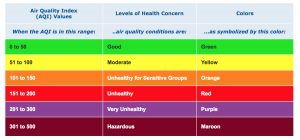Air quality forecasting was extended through the mid-point of this month after an abnormal summer. While the season began with news that the St. Louis region had once again escaped being ranked among the top 25 most-polluted U.S. cities, it’s still clear we struggle with unfavorable air quality here in the bi-state area. Despite the fact that air quality may not be top of mind when the temperature outside cools down and ozone pollution levels in the region drop, it remains extremely important to continue the fight for cleaner air all year-round.
A look back over the past several months reveals that our air quality took a hit earlier in the forecasting season than usual as we experienced a record-breaking heat wave with temperatures exceeding 100 degrees and the heat index topping 110+ degrees for six days in a row. That now ties the second-longest streak of extreme temperatures in the region’s history. Additionally, high ozone days and spikes in particle pollution due to Canadian wildfire smoke that caused some of the worst air quality ever in New York and other U.S. cities also negatively impacted St. Louis’ air quality several days this summer. These factors largely contributed to the 14 orange air quality days and singular red day in the region where conditions were unhealthy for sensitive populations, including children, older adults, people who work or exercise outdoors, and those with existing lung disease or cardiovascular disease.
From the beginning of May through Oct. 15, green was the dominant color with 77 days where the air quality was good, followed by 76 yellow or moderate air quality days. While this is positive news overall for the region, there is still much work to be done in the long-term quest for cleaner air to protect our local communities from the growing risks to public health resulting from increased levels of ozone and particle pollution. The Clean Air Partnership encourages area residents to remain steadfast in their efforts to take voluntary steps to reduce ozone-forming emissions 365 days a year, such as taking transit, carpooling, telecommuting, avoiding vehicle idling, not topping off your gas tank and combining errands into a single trip. Together, we can continue to make great strides in improving the quality of the air we all breathe!
Air quality forecasting will resume in May 2024. In advance of that, individuals can sign up to receive the color-coded daily forecasts if they are not already getting them via their email inboxes or text through the Environmental Protection Agency’s EnviroFlash air quality alert system at CleanAir-StLouis.com.
To learn more about the health effects of poor air quality and tips for doing your share for cleaner air, visit the Clean Air Partnership’s website, like us on Facebook or follow @gatewaycleanair on Twitter.

